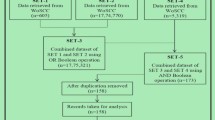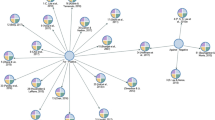Abstract
The most-followed Twitter users and their pairwise relationships form a subgraph of Twitter users that we call the Twitter elite network. The connectivity patterns and information exchanges (in terms of replies and retweets) among these elite users illustrate how the “important” users connect and interact with one another on Twitter. At the same time, such an elite-focused view also provides valuable information about the structure of the Twitter network as a whole. This paper presents a detailed characterization of the structure and evolution of the top 10K Twitter elite network. We describe our technique for efficiently and accurately constructing the Twitter elite network along with social attributes of individual elite accounts and apply it to capture two snapshots of the top 10K elite network that are some 2.75 years apart. We show that a sufficiently large elite network is typically composed of 14–20 stable and cohesive communities that are recognizable in both snapshots, thus representing “socially meaningful” components of the elite network. We examine the changes in the identity and connectivity of individual elite users over time and characterize the community-level structure of the elite network in terms of bias in directed pairwise connectivity and relative reachability. We also show that both the reply and retweet activity between elite users are effectively contained within individual elite communities and are generally aligned with the centrality of the elite community users in both snapshots of the elite network. Finally, we observe that the majority of the regular Twitter users tend to have elite friends that belong to a single elite community. This finding offers a promising criterion for grouping regular users into “shadow partitions” based on their association with elite communities.




















Similar content being viewed by others
Notes
In Twitter, each user u has a collection of followers that receive any tweets that u sends. u is called a friend for each one of its followers.
We use the terms nodes with the highest degree and the most-followed accounts interchangeably.
A user with many followers that is part of a partition or weakly connected region is not likely to be discovered by random walks. We argue that such an elite user is less important for our analysis.
The average degree obtained by dividing the number of directed edged |E| by the number of nodes given by the size of the elite network or view in the first column increases from roughly 40 to 115 for S16 and 37 to 110 for S18.
In a randomized degree-preserving version of the network, we randomly connect elite nodes while maintaining their in- and out-degrees.
We use a simple reordering algorithm along the x-axis to group unstable nodes that have a similar co-appearance pattern. Note that the sum of the values in each column is not \(100\%\) since a co-appearance of an unstable node with multiple resilient communities is counted separately.
References
Al-Garadi M (2018) Analysis of online social network connections for identification of influential users: survey and open research issues. ACM Comput Surv 51:1–34
Avrachenkov K, Litvak N, Prokhorenkova LO, Suyargulova E (2014) Quick detection of high-degree entities in large directed networks. In: Proceedings of ICDM, IEEE
Bakshy E, Hofman JM, Mason WA, Watts DJ (2011) Everyone’s an influencer: quantifying influence on twitter. In: Proceedings of WSDM, ACM
Blondel VD, Guillaume J-L, Lambiotte R, Lefebvre E (2008) Fast unfolding of communities in large networks. J Stat Mech Theory Exp 10:2008
Bollobás B (2013) Modern graph theory, vol 184. Springer, New York
Brin S, Page L (1998) The anatomy of a large-scale hypertextual web search engine. In: Proceedings of WWW, ACM
Cha M, Haddadi H, Benevenuto F, Gummadi PK (2010) Measuring user influence in Twitter: the million follower fallacy. In: ICWSM
Cha M, Mislove A, Gummadi KP (2009) A measurement-driven analysis of information propagation in the Flickr social network. In: Proceedings of WWW, ACM
Easley D, Kleinberg J (2010) Networks, crowds, and markets: reasoning about a highly connected world. Cambridge University Press, Cambridge
Fortunato S (2010) Community detection in graphs. Phys Rep 486(3):75–174
Gonzalez R, Cuevas R, Motamedi R, Rejaie R, Cuevas A (2016) Assessing the evolution of google+ in its first two years. IEEE/ACM Trans Netw (ToN) 24(3):1813–1826
Kwak H, Lee C, Park H, Moon S (2010) What is twitter, a social network or a news media? In: Proceedings of WWW, ACM
Leskovec J, Lang KJ, Dasgupta A, Mahoney MW (2009) Community structure in large networks: natural cluster sizes and the absence of large well-defined clusters. Internet Math 6(1):29–123
Motamedi R, Rejaie R, Lowd D, Willinger W, Gonzalez R (2014) Inferring coarse views of connectivity in very large graphs. In: Proceedings of COSN
Motamedi R, Rezayi S, Rejaie R, Light R, Willinger W (2016) Characterizing twitter elite communities. In: Technical report CIS-2016–15, University of Oregon, www.cs.uoregon.edu/Reports/TR-2016-015.pdf
Motamedi R, Rezayi S, Rejaie R, Willinger W (2018) On characterizing the twitter elite network. In: 2018 IEEE/ACM International conference on advances in social networks analysis and mining (ASONAM), pp 234–241
Puranik T, Narayanan L (2017) Community detection in evolving networks. In: Proceedings of ASONAM
Rejaie R, Torkjazi M, Valafar M, Willinger W (2010) Sizing up online social networks. IEEE Netw 24(5):32–37
Rosvall M, Bergstrom C (2007) Maps of information flow reveal community structure in complex networks. In: Proceedings of the national academy of sciences
Sobolevsky S, Campari R, Belyi A, Ratti C (2014) General optimization technique for high-quality community detection in complex networks. Phys Rev E 90(1):012811-1–012811-8
Stutzbach D, Rejaie R, Duffield N, Sen S, Willinger W (2009) On unbiased sampling for unstructured peer-to-peer networks. IEEE/ACM Trans Netw 17(2):377–390
Torkjazi M, Rejaie R, Willinger W (2009) Hot today, gone tomorrow: on the migration of myspace users. In: Proceedings of the ACM workshop on online social networks, pp 43–48
Valafar M, Rejaie R, Willinger W (2009) Beyond friendship graphs: a study of user interactions in flickr. In: Proceedings of the ACM workshop on online social networks, pp 25–30
Wikipedia. Sankey diagram. (2019), https://en.wikipedia.org/w/index.php?title=Sankey_diagram&oldid=740785912, Accessed: 2019 Apr 24
Yang J, Leskovec J (2013) Overlapping community detection at scale: a nonnegative matrix factorization approach. In: Proceedings of WSDM
Acknowledgements
We would like to thank Hooman Mostafavi for his help in collecting the second snapshot of the Twitter elite network. This material is based upon work supported by the National Science Foundation under Grant IIS-0917381 and CNS-1320977.
Author information
Authors and Affiliations
Corresponding author
Additional information
Publisher's Note
Springer Nature remains neutral with regard to jurisdictional claims in published maps and institutional affiliations.
Rights and permissions
About this article
Cite this article
Motamedi, R., Jamshidi, S., Rejaie, R. et al. Examining the evolution of the Twitter elite network. Soc. Netw. Anal. Min. 10, 1 (2020). https://doi.org/10.1007/s13278-019-0612-8
Received:
Revised:
Accepted:
Published:
DOI: https://doi.org/10.1007/s13278-019-0612-8




